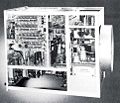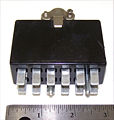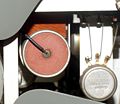517: Difference between revisions
No edit summary |
No edit summary |
||
| Line 113: | Line 113: | ||
|} | |} | ||
* [http://w140.com/tektronix_milspec_high_speed_scope.pdf Final Report on Tektronix MILSPEC High Speed Scope (5MB, PDF, cleaned up)] | |||
* [http://w140.com/MILSPEC_High_Speed_Scope.pdf Final Report on Tektronix MILSPEC High Speed Scope] | * [http://w140.com/MILSPEC_High_Speed_Scope.pdf Final Report on Tektronix MILSPEC High Speed Scope (220MB, PDF, original)] | ||
* [http://w140.com/tek_517_calibration.pdf Tektronix 517 Calibration Guide] | * [http://w140.com/tek_517_calibration.pdf Tektronix 517 Calibration Guide] | ||
* [http://w140.com/tek_517_early.pdf Early 517 Manual (PDF)] | * [http://w140.com/tek_517_early.pdf Early 517 Manual (PDF)] | ||
Revision as of 20:31, 25 September 2011
The Tektronix 517 is a 50MHz scope introduced in 1950 or 1951. The power supply is an external box, like the 507, 551 and 555. The 517 does not take plug-ins. There is also a 517A. The 517 closely resembles a scope that Tektronix developed under a contract for the US military during 1949 and 1950. (See link below.)
The external power supply and oscilloscope are connected by a removable cable with a Jones plug on one end and a Jones socket on the other end. Units with serial numbers from 101 through 1739 use 12-pin Jones 2412 connectors; after that it is a 16-pin Jones connector. The voltages on the 12-pin connector are:
- Pin 1: +750V, regulated
- Pin 2: +475V, regulated
- Pin 3: +350V, unregulated
- Pin 4: +225V, regulated
- Pin 5: +150V, regulated
- Pin 6: Ground
- Pin 7: -250V, regulated
- Pin 8: +180V, unregulated
The 517 makes extensive use of the distributed amplifier concept. Originally the 5XP CRT was used, which has 38V/cm vertical deflection sensitivity when operated with 24kV acceleration voltage. Since the vertical sensitivity at the input connector is 0.1V/cm, we can calculate that the voltage gain from the input connector to the vertical deflection plates is 380. For 4cm deflection, a 152-volt differential output swing is required. There are DC blocking capacitors at various places in the signal path. The slowest sweep is 20 us/cm. The 517 is not designed for low-frequency use. The vertical signal path is as follows:
- Gain Stage 1: single-ended, six sections, distributed, 6AK5 pentodes
- Gain Stage 2: single-ended, six sections, distributed, 6AK5 pentodes
- Gain Stage 3: single-ended, seven sections, distributed, 6AK5 pentodes
- Trig Pickoff: one common-cathode 6CB6 pentode
- Signal Delay: 51 feet of RG63U 125-ohm coaxial cable
- Phase Splitter: single-ended in, differential out, three sections, distributed, 6CB6 pentode
- Gain Stage 4: differential, six sections, distributed, 6CB6 pentodes
- Gain Stage 5: differential, twelve sections, distributed, 6CB6 pentodes
There is a trigger amplifier in the 517 which can take its input from an external source, or from the trigger pickoff in the vertical pre-amp, or from the internal rate generator circuit. The trigger amplifier circuit has five stages:
- Phase Splitter: 6J6 dual-triode connected as a differential amplifier
- Gain Stage 1: single-ended, three sections, distributed, 6AK5 pentodes
- Gain Stage 2: single-ended, three sections, distributed, 6AK5 pentodes
- Gain Stage 3: single-ended, common-cathode, 6AG7 pentode
- Gain Stage 4: single-ended, common-cathode, 6AG7 pentode
The 517 uses 24kV total acceleration voltage on the CRT. This is generated by the Type 420 High Voltage Power Supply subsystem in the 517. It uses a 1.8kHz oscillator to produce the high voltage, unlike other Tek scopes which use HV oscillators in the ultrasonic range.
The power consumption of a 517 is 1250 watts. The indicator unit weighs 76 pounds and the external power supply weighs 72 pounds.
517 units with serial numbers 101 through 925 use the DuMont 5XP CRT. Later units use a Tek-made CRT, the T517PxH/T54PxH, where "x" designates the phosphor type: 1, 2, 7, 11, or 16. The 5XP has three anode connections: 6.6kV, 13.3kV, and 20kV. The Tek-made CRT has just one anode connection, 20kV, and has 15 V/cm sensitivity at 24kV total acceleration voltage.
The 517 has a switch on the front panel that selects between normal vertical sensitivity, which uses the full 24kV acceleration voltage, and "X2" mode, which drops the acceleration voltage to 12kV for a doubling of the vertical sensitivity. The control works by switching the the voltage division ratio of the feedback to the error amplifier in the HV supply.
The 517 might be the only Tektronix instrument to have a part made of wood. There is a wood support for a large electrolytic capacitor, C826, which filters the probe power.
In 1965, following the introduction of the 50MHz 547, the 517 was discontinued. The 547 uses a non-distributed solid-state vertical amplifier, tunnel diode triggering, and a 6.5 V/cm CRT, thereby achieving good performance with lower cost, size, weight, complexity, and power consumption than the 517.
| 517A | 547 with 1A1 | |
|---|---|---|
| Bandwidth | 50MHz | 50MHz |
| Sensitivity | 50 mV/cm | 50 mV/cm |
| Cost in 1964 | $3500 | $2475 |
| Size | scope + power supply | all in one |
| Weight | 148 pounds | 71 pounds |
| Complexity | 130 tubes | 45 tubes |
| Power Consumption | 1250 watts | 510 watts |
- Final Report on Tektronix MILSPEC High Speed Scope (5MB, PDF, cleaned up)
- Final Report on Tektronix MILSPEC High Speed Scope (220MB, PDF, original)
- Tektronix 517 Calibration Guide
- Early 517 Manual (PDF)
- Later Manual Covering the 517 and 517A (PDF)
-
front
-
bottom internal
-
right internal
-
top internal
-
power supply internal
-
12-pin Jones socket on power supply
-
12-pin Jones plug
-
High voltage supply
-
Front view
-
12-pin Jones connector on indicator unit
-
Left internal view
-
Distributed vertical output amplifier
-
Wooden support for capacitor C826
-
Tek CRT Reference Chart
-
-
-
-
-
-
-
-
-
-
-
-
-
-
-
-
-
-
-
-
-
-



































